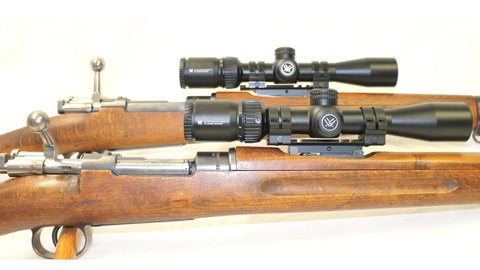

The use of unit markings on the bayonets ended in 1933, so if there are unit marks, that most likely means the bayonet was made before 1933. The last rifle to use this bayonet was the M1942 and it went out of service in 1964. Around 1905 the design was changed to a conical stud and single edge (One side being dull). The early versions had what was known as a flat locking stud and were double edged.

Starting around 1913 Carl Gustafs Stads Gevärsfaktori (“Rifle Factory of Carl Gustaf’s town”) (Crown/C) took over production. Once the sequence hit 999, they started the numbering at 001 again. The 3 digit bayonets numbering went up to 999.
#M38 HUSQVARNA SWEDISH MAUSER SERIAL#
They made 280,000 of which the first 10,000 had 4 digit serial numbers. Most of the bayonets were either made by Eskilstuna Jernmanufactur AB (EJ-anchor-AB) beginning around 1899 – 1912. The bayonets are called Swedish bayonets or Swedish 1896 bayonets. The Swedish Mauser has a rather nifty bayonet that can be attached to the rifle. Prior versions didn’t contain as much information and Earlier models contained either two screws or zero screws. The brass disk shown above is the latest version of the disks. A rating of 0 means there are no triangle stamps next to above any of the numbers.Ī little stamped triangle next to a number in each pie shape indicates deterioration of the gun. A rating of 0 means that the bore is almost new and a rating of 4 means the barrel should be replaced. The lower the number the better the bore is. The last or smallest slice indicates what condition the rifle bore is. This is really an indication of how high a bullet will strike the target in relation to point-of-aim. “Overslag” refers to over shooting, and the “str” is abbreviated for streck. “Torped” refers to the boat-tail 139gr m/41 bullet. The second biggest wedge represents how much to adjust the gun based on the M94 and M41 Swedish Mauser 1896 M96 cartridges. 0004″ apart, or 4 ten-thousandths of an inch. Bores were measured from 6.46 to 6.59mm and refer to the diameter of the bore. The largest slice or wedge represents the level of bore erosion. The disk gives some insight as to the condition of the weapon. One interesting note is each rifle comes with a brass disk fitted to the right side of the rifle stock. Sweden eventually replaced the Swedish Mauser with the shorter barrel version (7 inches shorter) called the M38 when in 1938 the new shorter Swedish Mauser rifle was being produced. Manufactures – Carl Gustafs Stads, Husqvarna, and Mauser Name – 1896 Mauser, M96 or Swedish Mauser

There were also about 8,000 Swedish volunteers that arrived armed with the Swedish Mauser M96s. Finland was provided about 77,000 of the M96 Swedish rifles throughout this period, but most of them came near the end of the conflict. The Fins stamped theirs with the letters “SA” for any Swedish Mauser used during the Russian War. The Swedish Mauser was used by the Finnish army against the Russians (Finnish-Russian War 1939-1940 also called the Winter War). Due to the tooling up period and slow production, some of these earlier models were also contracted out to be made by Mauser and later by Husqvarna during WWII. The actual production for the Swedish Mauser didn’t really start until 1898, when the Carl Gustafs federal armory started producing them. Swedish Mausers were manufactured in Sweden Carl Gustafs stads Gevärsfaktori, in Germany by Waffenfabrik Mauser Oberndorf a/N and by and Husqvarna Vapenfabriks Aktiebolag. One of the reasons for the high quality of the Swedish Mauser is because Sweden never entered wars like most other nations. It was also claimed to have been made from superior steel than the normal steel of the times. This process produced exceptional strength and corrosive-resistant properties. They required the guns to be manufactured using Swedish high-grade steel (Swedish Steel) and a mixture of various metals including copper, nickel and vanadium. While the Germans have always been known for their craftsmanship, the Sweds took craftsmanship to a new level with the Swedish Mauser. The rifle would remain basically unchanged until 1938, when a new shorter model would be introduced known as the M38 Swedish Mauser. The Swedish chose the 6.5x55mm cartridge and the 1896 Mauser or M96 as their rifle of choice. The Swedish Mauser as it is affectionately called got its beginnings in 1896.


 0 kommentar(er)
0 kommentar(er)
